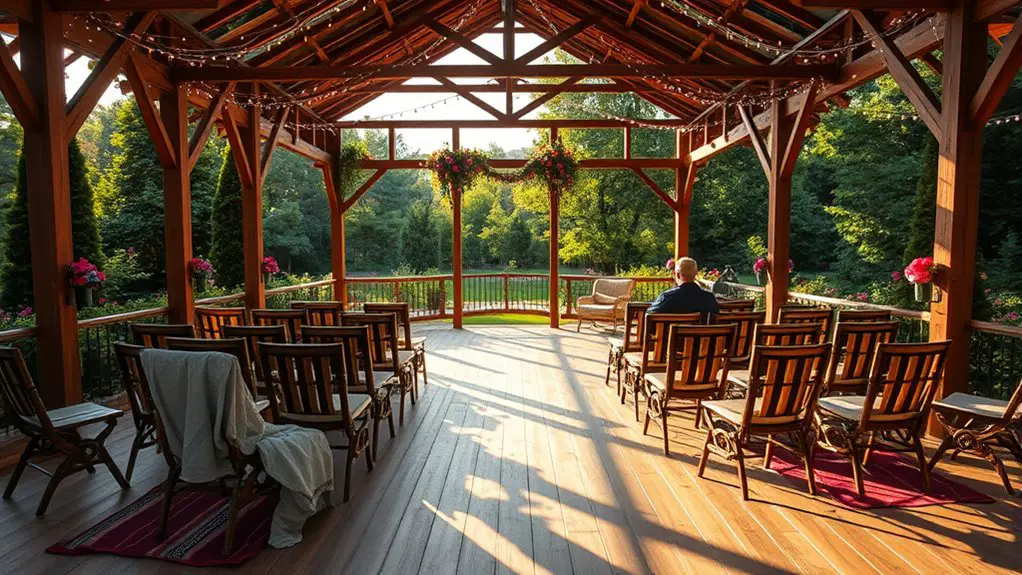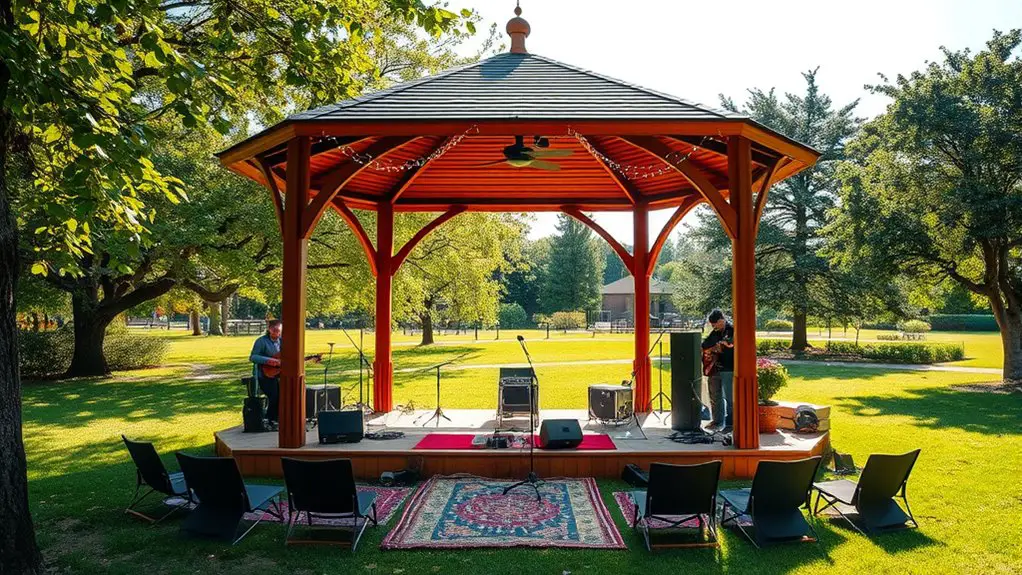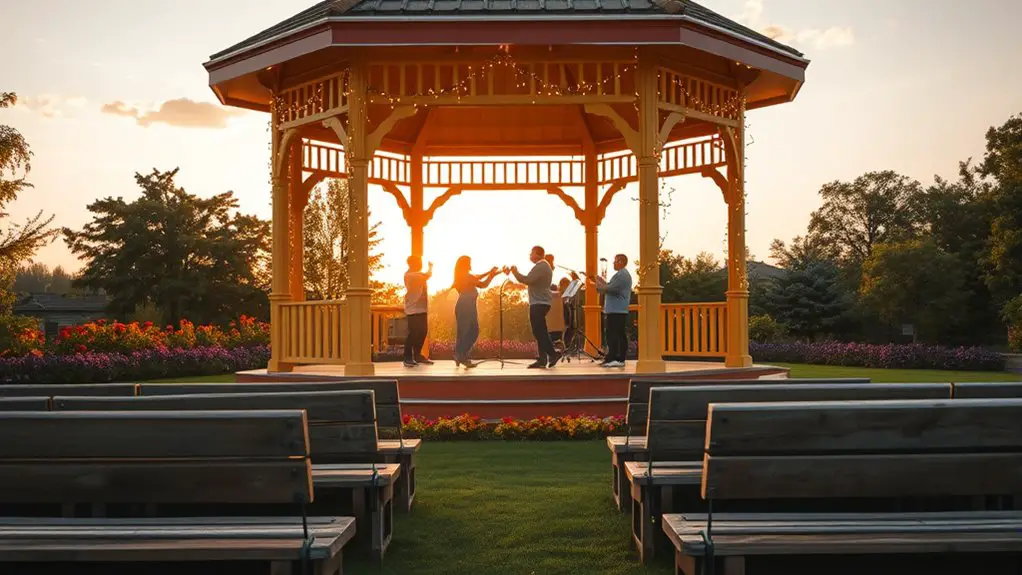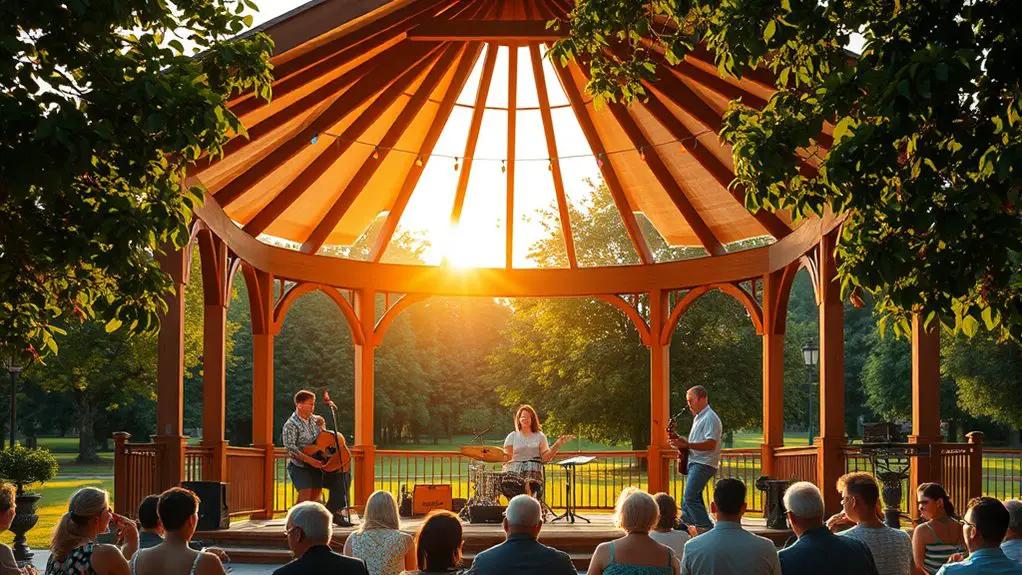To use your gazebo as a stage for local performances, start by evaluating its condition and ensuring it’s safe for artists and audiences. Enhance the ambiance with adjustable lighting and invest in a quality sound system for clear audio. Create a flexible layout that accommodates various performances, while offering comfortable seating for your audience. Promote your event through social media and local partnerships. There’s plenty more to explore to make your gazebo a vibrant performance venue.
Assessing Your Gazebo’s Suitability for Performances

Before you can transform your gazebo into an intriguing stage, it’s essential to assess its suitability for performances. Start by examining the gazebo condition—look for any signs of wear, such as loose boards or rusted fixtures. A sturdy structure is vital for safety and ensuring a seamless experience for both performers and the audience.
Next, consider the size and shape of your gazebo. Is it spacious enough for your performers and their equipment? A well-proportioned performance space allows for movement and creativity, making it easier to engage your audience. Think about the flooring, too; a flat, stable surface will prevent accidents and enhance sound quality.
Finally, evaluate the surrounding area. Is there enough room for your audience to gather comfortably? Ensuring a smooth flow between the gazebo and audience will create an inviting atmosphere, making your performances truly memorable. Additionally, consider the ideal placement of the gazebo, as its orientation can significantly impact sun exposure and overall comfort for attendees.
Enhancing the Ambiance With Lighting
When it comes to setting the right mood for your gazebo performance, lighting is your best friend. By exploring various types of stage lighting, experimenting with color schemes and effects, and positioning your lights for maximum impact, you can create an unforgettable atmosphere. Let’s illuminate the possibilities and transform your gazebo into a mesmerizing stage. Incorporating energy-efficient designs can also help reduce electricity costs while enhancing the visual appeal of your performance space.
Types of Stage Lighting
Creating the right atmosphere for your gazebo performance relies heavily on effective stage lighting. You can enhance your show with various lighting types that cater to your needs. Here’s a breakdown of some popular options:
| Lighting Type | Description |
|---|---|
| LED Lights | Energy-efficient and vibrant options. |
| Spotlight Effects | Focuses attention on performers. |
| Ambient Lighting | Sets a warm, inviting mood. |
| Stage Fog | Adds depth and drama to the lighting. |
| Color Gels | Modify light color to fit your theme. |
Utilize battery power for flexibility in placement, and invest in control systems to manage lighting effects seamlessly. Thoughtful light placement can transform your gazebo into an enthralling stage, inviting the audience into your performance.
Color Schemes and Effects
While selecting the right color schemes can seem intimidating, it’s essential for setting the mood of your gazebo performance. Consider the principles of color psychology; different hues evoke specific emotions. For example, warm colors like red and orange create excitement, while cool tones like blue and green foster calm.
To achieve color harmony, blend complementary shades that work well together, ensuring a cohesive look. Use lighting to enhance these colors—soft, diffused lights can create a dreamy atmosphere, while vibrant spotlights can energize the crowd. Think about how color affects your audience’s experience; the right scheme can transform your gazebo into a mesmerizing stage. Experiment with different combinations, and don’t hesitate to let your creativity flow!
Positioning for Maximum Impact
To elevate your gazebo performance even further, strategic positioning combined with thoughtful lighting can greatly enhance the overall ambiance. Start by placing your performers in a way that maximizes visibility for your audience. Consider the angle of the sun during the performance; you want to avoid glare while ensuring everyone can see.
Next, incorporate soft lighting—think string lights or lanterns—to create warmth and intimacy. Highlight performers with spotlights, drawing attention without overwhelming the visual aesthetics. Experiment with colors that complement your theme, which can boost audience engagement.
Finally, don’t forget to illuminate paths and surrounding areas for safety, creating an inviting atmosphere. With these enhancements, your gazebo will transform into a mesmerizing stage that resonates with freedom and creativity.
Setting Up the Sound System
A well-set sound system can transform your gazebo into a vibrant stage, enhancing the overall experience for both performers and audience members. To achieve ideal audio quality, you’ll want to focus on these three essential components:
- Speakers: Invest in quality sound equipment that can deliver clear and powerful sound. Position them strategically around the gazebo to guarantee even distribution.
- Mixer: A compact audio mixer allows you to control volume levels and effects for each performer. This way, you can adjust the sound in real-time to maintain balance.
- Microphones: Use dynamic or condenser microphones based on the performance type. Make sure they’re placed at the right distance to capture vocals without distortion.
Creating a Flexible Stage Layout

When creating a flexible stage layout for your gazebo, consider how the design can enhance the performance experience. You’ll want to think about seating arrangements that maximize visibility and comfort, as well as how lighting and sound setups can complement your artistic vision. By thoughtfully planning these elements, you can transform your gazebo into a dynamic performance space that adapts to any event.
Stage Design Considerations
While designing a stage in your gazebo, it’s essential to take into account flexibility, as this allows for various performances and events to thrive. Here are three key considerations to keep in mind:
- Stage Materials: Choose lightweight yet durable materials that can be easily assembled and disassembled, making alterations seamless between different performances.
- Performance Acoustics: Think about sound quality. Incorporate elements like sound-reflective surfaces or acoustic panels to enhance the auditory experience, ensuring every note resonates beautifully.
- Modular Design: Opt for a stage layout that can be adjusted based on the type of performance. This adaptability will give you the freedom to host everything from intimate concerts to lively theater productions with ease.
Seating Arrangement Options
Creating an inviting seating arrangement can greatly enhance the overall atmosphere of your gazebo stage, ensuring that every audience member feels engaged. Consider various seating styles to promote audience comfort while fostering a relaxed vibe. For a casual feel, use picnic blankets or folding chairs, allowing guests to spread out and choose their own spots. If you prefer a more formal setup, arrange rows of chairs facing the stage, ensuring clear sightlines for all. You might also mix and match seating options, creating small clusters for intimate conversations or larger groupings for a communal experience. By designing a flexible layout, you’re not just accommodating your audience; you’re inviting them to enjoy the performance in a way that feels personal and liberating.
Lighting and Sound Setup
Transforming your gazebo into an engaging stage requires careful attention to lighting and sound setup. A well-thought-out arrangement will enhance the performance experience for both the audience and performers. Here are three tips to get you started:
- Use wireless microphones – They provide freedom of movement for performers while minimizing clutter on stage.
- Consider acoustic elements – Pay attention to how sound travels within the gazebo. Adding rugs or curtains can help absorb sound and reduce echoes, creating a more intimate atmosphere.
- Incorporate adjustable lighting – Use a combination of spotlights and ambient lighting to set the mood. Dim or brighten as needed to suit different performances.
With these adjustments, your gazebo stage will shine!
Incorporating Seating for the Audience

When you plan to host an event in your gazebo, incorporating seating for the audience is essential for ensuring comfort and engagement. You want your guests to feel relaxed so they can fully enjoy the performance. Here’s a quick guide to different seating types to contemplate:
| Seating Type | Description |
|---|---|
| Folding Chairs | Lightweight, easy to set up and store. |
| Benches | Can accommodate larger groups; sturdy. |
| Picnic Blankets | Casual and creative for a laid-back vibe. |
Think about your audience comfort when selecting seats. Folding chairs work great for formal events, while benches can create a more communal atmosphere. Don’t forget picnic blankets for a fun, relaxed feel. With the right seating, you’ll keep your audience engaged and ready to enjoy the show! Additionally, consider the gazebo’s design and aesthetics to enhance the overall outdoor atmosphere of your performance space.
Promoting Your Event to the Community
How can you guarantee your gazebo event reaches the widest audience possible? Effective community outreach and event marketing are key to drawing in attendees. Here are three strategies to contemplate:
- Leverage Social Media: Use platforms like Facebook and Instagram to create buzz. Share engaging content, sneak peeks of performances, and behind-the-scenes moments to pique interest.
- Partner with Local Businesses: Collaborate with nearby shops or restaurants to promote your event. They can help spread the word through their networks, and you might even secure sponsorship or donations in return.
- Create Eye-Catching Flyers: Distribute colorful flyers in high-traffic areas. Be sure to include essential details and a compelling call to action, inviting the community to join in the fun.
Planning for Weather Contingencies
Even with the best marketing strategies, unpredictable weather can put a damper on your gazebo event. To guarantee your performance goes off without a hitch, start by closely monitoring weather forecasts leading up to the day. This will help you gauge the likelihood of rain or storms.
Consider investing in a quality rain cover for your gazebo. Not only will it protect your performers and equipment, but it also shows your audience that you’ve planned for contingencies. If the forecast indicates inclement weather, communicate with your performers and audience about potential changes—whether that means relocating to a more sheltered spot or rescheduling for a sunnier day. Additionally, choose a gazebo with hardtop materials that can withstand heavy snow and rain, ensuring a safe environment for your event.
Finally, have a backup plan in place. This could involve a nearby indoor venue or an alternative date. By being proactive, you’ll guarantee that your event remains a celebration of creativity, no matter what Mother Nature throws your way.
Engaging Local Talent and Performers
While organizing your gazebo event, engaging local talent and performers can elevate the experience and foster community spirit. By showcasing local artists, you not only support their craft but also create a vibrant atmosphere. Here are three ways to engage your community effectively:
- Host Auditions: Invite local artists to audition for your event. This not only gives them a platform but also allows you to discover exciting new talent.
- Collaborate with Schools: Partner with local schools or art programs to feature student performances. This promotes community engagement and encourages young talent.
- Create a Variety Showcase: Offer a mix of music, dance, and spoken word performances. This variety appeals to different audiences and keeps the event dynamic. Additionally, utilizing the gazebo as a stage enhances outdoor living space and provides a unique setting for performances.
Frequently Asked Questions
What Types of Performances Can Be Held in a Gazebo?
You can host various performances in your gazebo, like musical concerts that fill the air, poetry readings that inspire, dance recitals that dazzle, and community theater that brings everyone together, celebrating creativity and connection.
How Do I Obtain Permits for Public Performances?
To obtain permits for public performances, you’ll need to submit a permit application to your local government. Check local regulations to guarantee compliance, and don’t hesitate to ask for guidance if you encounter confusion.
Can I Charge Admission for Events in My Gazebo?
Yes, you can charge admission for events in your gazebo, but you’ll need to check local regulations for event licensing. Make sure to comply with any requirements to avoid issues while enjoying your performances.
What Safety Measures Should Be Considered for Performers?
When planning performances, you should prioritize audience safety and consider requiring performer insurance. Guarantee proper lighting, secure the stage area, and have emergency plans in place to create a safe, enjoyable environment for everyone involved.
How Can I Collaborate With Local Schools or Organizations?
Imagine a vibrant tapestry of talent weaving through your community. To collaborate, reach out to local schools and organizations, proposing performance workshops that foster creativity and connection, nurturing young talents and enriching your community outreach efforts.

